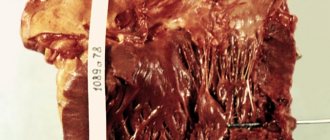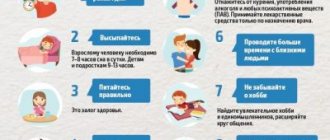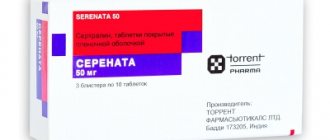Irina Baranova
Cardiologist
Higher education:
Cardiologist
Kuban State Medical University (KubSMU, KubSMA, KubSMI) Level of education - Specialist 1993-1999
Additional education:
“Cardiology”, “Course on magnetic resonance imaging of the cardiovascular system”,
Research Institute of Cardiology named after. A.L. Myasnikova
"Course on functional diagnostics"
NTsSSKh them. A. N. Bakuleva
"Course in Clinical Pharmacology"
Russian Medical Academy of Postgraduate Education
"Emergency Cardiology"
Cantonal Hospital of Geneva, Geneva (Switzerland)
"Therapy course"
Russian State Medical Institute of Roszdrav
Contacts
With vegetative-vascular dystonia, patients often complain of pain in the heart. Dystonia leaves a special imprint on the manifestation of these pains. The symptoms are not fatal, but they significantly exhaust the body, affecting a person’s quality of life. Constant anticipation of a crisis and panic attacks during heart failure are just a few signs of a pathological condition.
General characteristics of pain in the heart with VSD
Based on the name of vegetative-vascular dystonia, one might think that the problem lies in the blood vessels. This is not so - the disease is largely associated with disruption of the functioning of the human autonomic system.
The appearance of tingling or compression of the heart in this pathology occurs as a result of dysfunction of the nervous system or hormonal imbalance.
Usually a person does not think about the seriousness of the disease and attributes periodic heart pain to fatigue and overwork. However, the disease progresses and makes itself felt more and more often. To avoid complications, it is necessary to take the symptoms that arise seriously.
Symptoms indicating cardiac VSD
In order not to confuse heart pain during VSD with symptoms of serious pathologies, you need to learn to distinguish what cardialgia, tachycardia, arrhythmia, ischemia and other terms of cardiac disorders are.
Tachycardia is a heart rhythm disorder when the contraction frequency exceeds normal and reaches more than 90 beats. My heart feels like it’s fluttering and ready to jump out of my chest. The failure can be detected even at home.
Ischemia is a disturbance in the process of blood circulation in the heart area caused by a lack of oxygen. Problems with blood vessels that are narrowed or blocked by plaque limit the flow of enriched blood to the heart.
Cardialgia is a manifestation of pain in a specific area, the left side of the chest, but it is impossible to call this pain a sign of cardiac pathologies if pathological changes in the heart muscle are not recorded during an attack.
Recognizing cardialgia from other cardiac diagnoses consists of providing first aid when pain in the heart occurs. For heart problems, pain decreases after taking Nitroglycerin, Validol. Pain in the heart during VSD cannot be relieved with the mentioned means, because the cause is a violation of the autonomic (parasympathetic or sympathetic) function, and not the coronary artery.
Patients with disorders in the autonomic system usually indicate the following discomfort in the chest:
- Colitis;
- Cuts;
- Freezes;
- Presses;
- Compresses;
- Burns;
- The presence of a foreign object is felt in the chest, which affects the overall well-being. In fact, there are no foreign objects in the chest and heart area. But the brain perceives a disruption in the nervous system as a threat to the heart;
- My head is spinning;
- The pain goes to the neck, under the shoulder blade;
- When pressing on the cervical spine, pain is also felt;
- Breaks into sweat;
- There is an overwhelming feeling of fear that he will soon die;
- Due to the panic state, breathing problems occur.
Many symptoms of heart pain with VSD are similar to signs of heart failure or other pathology. But panic may be unfounded and there is no threat to life. If you distract a patient during heart pain with a conversation or an object, the discomfort may disappear without medical intervention. The signal to the nervous system about a failure in the heart area will be switched to other information and the spasm will disappear, which indicates the manifestation of symptoms of vegetative vascular dystonia.
Causes of heart pain in vegetative-vascular dystonia
Similar sensations against the background of VSD most often result from:
- Frequent physical activity. Lifting heavy objects (working as a loader or doing weightlifting) and prolonged physical activity of the body lead to the development of VSD and the appearance of pain in the heart.
- Chronic fatigue. Psychosomatic abnormalities and periodic exposure to stressful situations for the body negatively affect the condition of the heart. Along with heart pain, panic attacks and dizziness are observed in this case.
- Sleep disturbances. To feel well, you should get enough sleep, and this is especially true when diagnosed with VSD. A person cannot always afford proper sleep and rest; as a result of lack of sleep, pain appears in the chest.
- Women are prone to heart pain with vegetative-vascular dystonia due to hormonal imbalances, including during premenstrual syndrome and menopause.
- Sudden change of weather. Weather-sensitive people are susceptible to chest pain due to VSD due to climate change or time of year.
- Alcohol abuse. Alcohol always puts a heavy burden on the heart, and this is even more aggravated by vegetative-vascular dystonia. The state of intoxication negatively affects the overall functioning of the heart muscle due to the constant narrowing and dilation of blood vessels.
- Depression. A common phenomenon with VSD is a depressed mental state of the body, which negatively affects the functioning of the heart.
- Anxious and suspicious personality disorders. These are abnormalities associated with mental disorders that cause a constant feeling of anxiety and are accompanied by panic attacks, and also affect the heart.
Why does this happen
Why does the heart hurt with VSD? Chest discomfort is explained by:
- Alcohol abuse.
- Changes in weather conditions.
- Overwork.
Some people experience heart pain after stress. In women, this symptom occurs against the background of premenstrual syndrome.
Spasmodic vascular reaction
The main cause of stress is emotional experiences. The sympatho-adrenal system receives the stimulus. Against the background of overexcitation of the neurohumoral adaptation mechanism, activity of the sympathetic nervous system is observed.
This affects the vascular and cardiac systems as follows:
- the heart rate decreases;
- vascular spasms appear;
- blood pressure increases.
Against the background of a decrease in blood flow to the heart muscle, the lumen decreases. This leads to myocardial ischemia. Quite severe pain appears behind the sternum.
Psychogenic cardialgia
Pain in the heart during VSD is called cardioneurosis. This is a psychosomatic condition. The sympathetic-adrenal system plays an important role here.
The root cause of discomfort is considered to be a depressed emotional state of a person. This causes pain due to nerves. This is often accompanied by depression or neurosis.
How does the heart hurt with vegetative-vascular dystonia?
With VSD, the nature of heart pain can be different:
- Pain radiating to the left side of the chest close to the shoulder blade, which may extend into the left arm and affect the lower left side of the face.
- Intense or sharp increasing pain in the form of spasms. The heart contracts and unclenches, a person feels with his whole body how the heart beats and at the same time periodically freezes.
- Point or stabbing pain - a feeling as if thin needles are piercing the heart. It occurs in the form of frequent tremors and spasms.
- Prolonged pain or pain with cutting spasms. The patient complains of noticeable discomfort, as if the heart muscle is being “cut.”
- Pressing pain - a spasm in the form of pressure can often occur, as if some strong force is being applied to the chest from the outside.
Feeling pain in the heart area as a symptom of VSD
Heart pain is one of the symptoms of VSD.
VSD is rich in symptoms, including fatigue, impaired performance, dizziness, palpitations and panic attacks. But nothing is more alarming than heaviness in the heart. People describe the nature of the spasms in different ways: it hurts, it hurts, it hurts, it cuts. Some people perceive a spasm in the form of a foreign object that presses on the chest. No matter how the discomfort is described, there are several types of pain:
| Type of heart pain | Signs | Recommendations for relief |
| Depressed |
| It is important to calm the nervous system and herbal teas based on mint or lemon balm, menthol lozenges, and valerian infusion will help with this. |
| Intensive |
| The heart can be helped by applying mustard plaster to the chest and taking sedatives. If necessary, you can resort to the help of antispasmodics. |
| Protracted |
| Since the symptoms are similar to those of a heart attack, it is better to call a doctor. |
| Spot |
| Nitroglycerin will eliminate discomfort in 5 minutes. |
| Physical |
| The pain does not go away immediately after physical activity; a long rest is required. |
Is VSD syndrome dangerous?
Validol will calm and eliminate an attack of pain in the heart during VSD.
Types of heart pain in VSD are combined into the concept of “cardiac syndrome” - acute chest pain that occurs for no reason or after physical activity. This syndrome causes panic and fear for life. But considering that attacks of cardialgia are caused by neuroses and stress, and not by heart dysfunction, all that remains is to treat the syndrome and not let the situation take its course.
Cardialgia with vegetative-vascular dystonia is not life-threatening and can be easily eliminated with sedatives or Validol.
Additional symptoms of VSD
In addition to heart spasms, the disease can be distinguished by other features that interfere with the normal course of life:
- there are surges in blood pressure;
- heart rate changes;
- headache and dizziness (usually not to the point of fainting);
- extraneous sounds are heard in the ears;
- absent-mindedness and lethargy are observed;
- body temperature rises;
- I'm worried about mood swings.
Diagnostics
Any pain symptom in the heart should prompt a visit to the doctor, however, at the first examination, the therapist may not make the correct diagnosis, telling the patient that there are no problems with the heart. This does not mean that you can ignore unpleasant symptoms in the future.
To assess the condition of the heart muscle, a comprehensive diagnosis should be carried out, consisting of the following examinations:
- ECG - determines the functional state of the heart;
- ECHO is one of the ultrasound methods; the study shows changes in the valvular apparatus of the heart and general morphology;
- MRI of the heart allows you to obtain maximum information about the physical condition of the organ.
All these activities will help establish a diagnosis and prescribe treatment. If the heart muscle itself is in perfect order, and the blood vessels are functioning as they should, the doctor is inclined to assume that the disorder is only in the autonomic and nervous system.
What contributes to the appearance of pain symptoms in VSD?
Symptoms of VSD of any kind occur unexpectedly, but can be repeated systematically and make everyday life unbearable. Chest pain is provoked by a person’s psychological or physiological state. If there is constantly stress, tension, a sense of responsibility for some kind of obligation, then there is no opportunity for rest and relaxation. The body is overloaded and causes a spasm in the heart area. Although in fact the autonomic system reacts, sending pain impulses.
Pain in the heart during VSD is provoked by chronic inflammatory processes, which until a certain time were not paid attention to.
For example, muscular neuralgia in the cervical region, vertebral chondrosis, hernia. Pain spreads in the sternum, neck, and spine. Any physical activity on the shoulder girdle provokes an attack of pain, but not at the moment of exertion, but after a certain period.
The following circumstances contribute to the appearance of pain in the heart during VSD:
- Anxiety;
- Permanent or temporary stress - preparation for an exam, performance, dissatisfaction with work;
- Suspiciousness, when any rustle, sound, gesture is perceived as a threat, pain in the body as a symptom of a serious illness;
- Depression;
- Meteosensitivity when weather changes;
- Sudden temperature change;
- Fright;
- Sleep disturbances;
- Annoying factors of the surrounding reality - repairs at the neighbors for a long time, the crying of a child, the noise of the highway and much more that lasts constantly;
- Chronic diseases in neurology.
There may be more factors that influence the appearance of symptoms of pain in the heart area during VSD. Each case is individual and requires a unique treatment protocol. Treatment of serious heart problems, such as heart attack, ischemia, tachycardia, arrhythmia, is always carried out according to a proven algorithm.
Treatment and first aid
An attack of heart pain can seriously harm your health. Be extremely careful and follow the instructions below to avoid complications.
If pain in the heart becomes more frequent, and breathing becomes more and more difficult, first aid should be provided. It is important to do this in the next half hour, starting with the first urge:
- Provide the patient with access to fresh air. Open the windows in the room and ventilate it.
- Stop the physical impact on the body: sit down, or better yet, lay the victim down.
- Get rid of clothes that constrict the chest and put pressure on it, or even remove the upper part of the clothes completely.
- Give the medicine in the form of tablets or drops. What exactly should be taken depends on the symptoms. Usually this is “Aspirin”, “Glycine”, “Panangin” or “Corvalol”.
- Check your pulse. The heart rate should not be higher than 120 beats; 20 minutes after taking the medication, the heart rate should decrease.
Further treatment is determined by a comprehensive examination and the doctor prescribing the necessary medications to eliminate subsequent attacks and pain that arise during stress or emotional changes.
Treatment of VSD symptoms is provided by drug therapy, psychotherapy, and physiotherapy (acupuncture). To cope with pain in the chest area on your own, you should normalize your sleep schedule and take sedatives in a timely manner.
During treatment of the vegetative-vascular system, each patient requires an individual approach. For some, the treatment will be a long and calm conversation along with the use of sedatives. Someone resorts to the help of a psychotherapist, and some patients will be able to come to their senses only after using tranquilizers prescribed by the doctor. Breathing exercises will not be superfluous, which will help get rid of panic attacks and create comfortable conditions for the work of the heart muscle.
Nature of pain
Vegetative-vascular dystonia occurs in the adult population in up to 70% of cases. People at a doctor's appointment complain of heart pain. There is an increase in heart rate. Moreover, the pain radiates to the cervical region, shoulders, and sternum.
Along with pain, a person experiences dizziness, often accompanied by fainting and suffocation. The patient's palms sweat, temperature and blood pressure fluctuate, sleep is disturbed, and panic attacks appear.
All patients usually have the same type of pain - aching with frequent tingling. People experience a feeling of suffocation, interruptions and burning in the heart area, and difficulty breathing. Many people complain of having a foreign body in the chest. The sensation of pain may last a few seconds or longer. This is where so-called panic attacks appear.
Prognosis and prevention
After detecting abnormalities in the functioning of the heart during VSD, it is necessary to constantly monitor the condition of the body, especially during hard work. Comfortable work and a calm environment will contribute to the health and proper functioning of the heart.
You can get rid of heart pain due to VSD if you act purposefully and gradually, creating conditions for positive psychological influence and reducing physical stress on the body. For this:
- follow your daily routine - it is important to have healthy sleep;
- eat right: exclude fatty and salty foods from food, which will have a positive effect on the functioning of the heart;
- toughen up: strengthening the immune system has a positive effect on the functioning of the heart;
- take walks in the fresh air - oxygen saturation has a beneficial effect on the body;
- learn self-control - it is necessary to suppress unnecessary emotions that negatively affect the heart.
As a preventative measure, after you have managed to get rid of the symptoms of the disease, you should continue to take actions aimed at maintaining your health. These recommendations are universal and have a healing effect on the entire body as a whole.
It is also necessary to be periodically examined by a doctor in order to detect a relapse of the disease in time (vegetative-vascular dystonia cannot be eliminated forever). Experts advise undergoing an examination every six months to monitor changes in the body.
If you suffer from vegetative-vascular dystonia, you need to monitor the condition of your heart, take medications prescribed by your doctor on time, do not forget about your daily routine and avoid stressful situations. Self-control and self-organization are key points on the path to a healthy heart during VSD.












